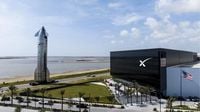In a remarkable leap forward for space exploration, two major players—Thales Alenia Space alongside the Italian Space Agency (ASI), and SpaceX—are advancing humanity's ambitions beyond Earth with groundbreaking projects targeting the Moon and Mars. These developments, announced in late July 2025, underscore a new era of international collaboration and private enterprise pushing the boundaries of what’s possible in space.
On July 28, 2025, Thales Alenia Space (TAS) and ASI signed a landmark contract to build the first human base on the Moon. This initiative is a pivotal part of NASA’s Artemis lunar exploration program, which aims to use the Moon as a proving ground for future missions to Mars. The Artemis Program has grown into a multinational effort involving dozens of private companies, including SpaceX, making it one of the most ambitious space endeavors in recent history.
The centerpiece of this lunar base will be a multi-purpose habitation module designed to sustain a permanent human presence on the Moon’s surface. Scheduled to launch from NASA’s Kennedy Space Center, this module promises to be a safe, comfortable, and highly versatile habitat. It will be compatible with various international systems and capable of conducting scientific research autonomously, even when uncrewed. Moreover, the module will have the mobility to traverse the lunar surface, enabling it to support a range of exploratory and operational activities.
Teodoro Valente, President of the Italian Space Agency, highlighted the strategic importance of this project: "The future lunar module is a cornerstone of Italy's long-term investment strategy and positions us to play an increasingly active role in the new space race." Indeed, this contract not only marks Italy’s growing footprint in the global space sector but also reflects a broader commitment to developing innovative technologies capable of withstanding the Moon’s harsh environment—characterized by extreme radiation, low gravity, and pervasive dust.
Under a two-year contract, Thales Alenia Space will act as the general contractor, collaborating closely with ALTEC—a joint venture between TAS and ASI—and other key Italian industries. The module is expected to have a service life of at least 10 years, setting the stage for sustained human activity on the Moon. This lunar base is envisioned as a springboard for deeper space exploration, including eventual missions to Mars.
Meanwhile, SpaceX is making strides on its own ambitious front. The private aerospace company recently moved the latest iteration of its Starship spacecraft, dubbed the "V2 Starship," to its Starbase facility in Texas for preflight testing. CEO Elon Musk shared images of the Starship being transported on a moving platform to the launch tower at the South Texas Launch Site, SpaceX’s primary testing and production hub since 2014.
Starship represents a revolutionary leap in spaceflight technology. As the only privately owned, fully reusable super heavy-lift launch vehicle currently under active development, it promises to dramatically reduce the cost of sending payloads into orbit. This capability is crucial for ambitious missions like NASA’s Artemis program and the long-term goal of establishing a human colony on Mars.
Musk has expressed optimism about the rapid development of the Starship series, hoping to launch the next iteration, the "V3 Starship," by the end of 2025. The company plans to send five Starships on an uncrewed test mission to Mars during the 2026 planetary alignment, followed by missions in 2028-2029 deploying up to 20 ships to deliver equipment and infrastructure critical for future human landings, which are targeted between 2030 and 2031.
However, the road has not been without setbacks. In June 2025, a SpaceX Starship launch ended in an explosion during a static test fire. Investigations traced the failure to an issue with the pressurized nitrogen tank in the ship’s nose cone. Despite this, SpaceX remains committed to pushing forward, with the next manned launch scheduled for August 2025.
SpaceX has emphasized the broader significance of Starship beyond commercial and scientific goals. In a March statement, the company said, "Access to space is a critical and growing need for U.S. national security, leadership in science, the country's exploration goals, and for the growth of the economy. Starship will ultimately be responsible for sending millions of tons of payload to Mars—building a self-sustaining city to make humanity multiplanetary." This vision aligns closely with NASA’s objectives and the Artemis program, illustrating the increasingly symbiotic relationship between government agencies and private companies in space exploration.
Together, these projects reflect a dynamic moment in space history. Italy’s commitment to developing a lunar base through Thales Alenia Space and ASI signals the expanding international participation in space, while SpaceX’s Starship advances the technological capabilities necessary for interplanetary travel. Both efforts underscore the growing momentum toward establishing a sustained human presence beyond Earth, from the Moon to Mars.
While the Artemis program continues to evolve with these new partnerships and technologies, the challenges remain formidable. Surviving the Moon’s harsh environment demands cutting-edge innovation, and the technical complexities of reusable spacecraft require relentless testing and refinement. Yet, the progress made so far offers a tantalizing glimpse of a future where humans live and work on other worlds.
As these ambitious projects unfold, the world watches with anticipation. The next decade promises to redefine humanity’s place in the cosmos, fueled by international cooperation, private enterprise, and an unyielding spirit of exploration.

